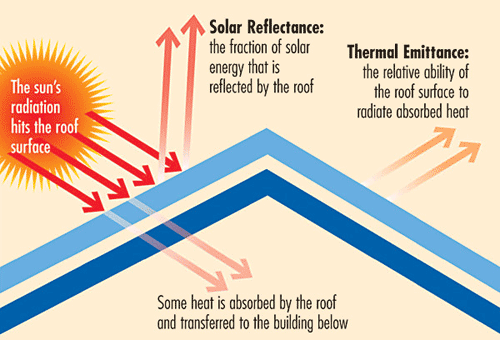What's So Cool About Cool Roofs?
 |
This diagram shows solar radiation on a roof surface. Image courtesy of Cool Roof Rating Council |
SOLAR REFLECTANCE INDEX (SRI)
Codes, standards and programs that specify cool roofing requirements may also reference an additional calculated value,the Solar Reflectance Index (SRI). SRI allows actual measured solar reflectance and thermal emittance values to be combined into a single value by determining how hot a surface would get relative to standard black and standard white surfaces.
 The standard black roofing material has a high emittance value (90 percent) but a low reflectance value (5 percent). This creates a hot roof surface because even though the emittance is high, there isn't enough reflectance to help cool the roof. As such, the standard black roof is given an SRI value of 0.
The standard white roofing material is highly reflective (80 percent) and has the same emittance as the standard black surface (90 percent). Its surface is much cooler and the standard white roof is assigned an SRI value of 100. Like solar reflectance and thermal emittance, a higher SRI value is synonymous with a cooler roof.
Calculating SRI
Lawrence Berkeley National Laboratory hosts an easy-to-use SRI calculator on their website. All that is required is the solar reflectance and thermal emittance values and the tool will calculate the SRI. The calculator is located at: coolcolors.lbl.gov/assets/docs/SRI%20Calculator/SRI-calc10.xls
COOL ROOFS EQUATE TO BIG BENEFITS TO THE OWNER AND THE ENVIRONMENT
When properly installed and maintained, cool roofs provide numerous benefits that contribute to the health of a community, to the occupants of the building and to the owner's pocket book.
Among the benefits to the building occupants and owner are:
Improved comfort because the building's interior is subject to less thermal flux and stays cooler during the warm season.
Reduced energy costs because of reduced air-conditioning.
Longer AC unit life resulting from decreased air-conditioning loads.
Increased roof longevity due to reduced thermal flux.
Cool roofs are distinguished among energy conservation measures because of the many environmental benefits they can provide. This is attributed to the fact that they combat the urban heat island effect. The urban heat island effect is a relatively newly identified phenomenon that is characterized by a measured increase in the ambient air temperature in cities over their surrounding rural areas. This is due to roofs and other non-reflective surfaces that absorb and trap solar radiation - or heat. The excess trapped heat is gradually released to the ambient air throughout the day, evening and nighttime hours, warming up the urban core round the clock. The effect results in an environmentally negative and spiraling impact, including:
Increased demand for air-conditioning in both air-conditioned and un-conditioned buildings, thus increasing the potential for the installation of air-conditioners in buildings that currently don't need them.
Increased greenhouse gas emissions that contribute to global warming, released as a result of fossil fuel generated electricity to power air conditioners.
Increased smog formation.









